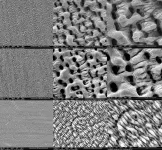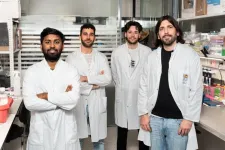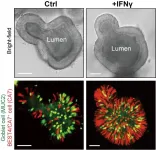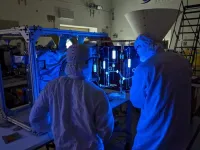(Press-News.org) COLUMBUS, Ohio – Researchers have developed a battery that can convert nuclear energy into electricity via light emission, a new study suggests.
Nuclear power plants, which generate about 20% of all electricity produced in the United States, produce almost no greenhouse gas emissions. However, these systems do create radioactive waste, which can be dangerous to human health and the environment. Safely disposing of this waste can be challenging.
Using a combination of scintillator crystals, high-density materials that emit light when they absorb radiation, and solar cells, the team, led by researchers from The Ohio State University, demonstrated that ambient gamma radiation could be harvested to produce a strong enough electric output to power microelectronics, like microchips.
To test this battery, which is a prototype about 4 cubic centimeters small, researchers used two different radioactive sources, cesium-137, and cobalt-60, some of the most significant fission products that come from spent nuclear fuel. The battery was tested at Ohio State’s Nuclear Reactor Laboratory. The NRL supports student and faculty research, student education, and service to industry – it does not produce electrical power.
Their results showed that when cesium-137 was used, the battery generated 288 nanowatts. Yet with the much stronger isotope cobalt-60, the battery produced 1.5 microwatts of power, about enough to switch on a tiny sensor.
Although most power outputs for homes and electronics are measured in kilowatts, this suggests that with the right power source, such devices could be scaled up to target applications at or beyond the watts level, said Raymond Cao, lead author of the study and a professor in mechanical and aerospace engineering at Ohio State.
The study was recently published in the journal Optical Materials: X.
The researchers said these batteries would be used near where the nuclear waste is produced, such as in nuclear waste storage pools or nuclear systems for space and deep sea exploration – they aren’t designed for public use. Fortunately, although the gamma radiation utilized in this work is about a hundred times more penetrating than a normal X-ray or CT scan, the battery itself does not incorporate radioactive materials, meaning it is still safe to touch.
“We're harvesting something considered as waste and by nature, trying to turn it into treasure,” said Cao, who also serves as the director of Ohio State’s Nuclear Reactor Lab.
According to the study, the team’s battery may also have experienced an increase in power due to the makeup of the prototype scintillator crystal the team opted to use. They found that even the shape and size of the crystals can impact the final electrical output, as a larger volume allows it to absorb more radiation and convert that extra energy into more light. A larger surface area also helps the solar cell generate power.
“These are breakthrough results in terms of power output,” said Ibrahim Oksuz, co-author of the study and a research associate in mechanical and aerospace engineering at Ohio State. “This two-step process is still in its preliminary stages, but the next step involves generating greater watts with scale-up constructs.”
Since batteries of this type would most likely end up in environments where high levels of radiation already exist and aren't easily accessible to the public, these long-lasting devices wouldn’t pollute their surroundings. Even more significantly, they could also operate without the need for routine maintenance.
Scaling this technology up would be costly unless these batteries could be reliably manufactured, said Cao. Further research is needed to assess the batteries’ usefulness and limitations, including how long they might last once safely implemented, said Oksuz.
“The nuclear battery concept is very promising,” he said. “There's still lots of room for improvement, but I believe in the future, this approach will carve an important space for itself in both the energy production and sensors industry.”
This work was supported by the U.S. Department of Energy’s National Nuclear Security Administration and the U.S. Department of Energy’s Office of Energy Efficiency and Renewable Energy. Other co-authors include Sabin Neupane and Yanfa Yan from The University of Toledo.
END
Scientists design novel battery that runs on atomic waste
Strong nuclear radiation boosts device efficiency, study finds
2025-02-25
ELSE PRESS RELEASES FROM THIS DATE:
“Ultra-rapid” testing unlocks cancer genetics in the operating room
2025-02-25
A novel tool for rapidly identifying the genetic “fingerprints” of cancer cells may enable future surgeons to more accurately remove brain tumors while a patient is in the operating room, new research reveals. Many cancer types can be identified by certain mutations, changes in the instructions encoded in the DNA of the abnormal cells.
Led by a research team from NYU Langone Health, the new study describes the development of Ultra-Rapid droplet digital PCR, or UR-ddPCR, which the team found can measure the level of tumor cells in a tissue sample ...
Mimicking shark skin to create clean cutting boards
2025-02-25
WASHINGTON, Feb. 25, 2025 – Keeping work surfaces clean during meat processing is a challenge. Bacteria from meat can attach, grow, and build up to create a biofilm that is difficult to remove, even on stainless steel surfaces used in industrial facilities. It can also aggregate, clumping together into an invisible mass that is stronger than individual cells, making it harder to kill using food-grade antibacterial surface cleaners.
In a paper published this week in Journal of Laser Applications, from AIP Publishing and the Laser Institute of America, researchers from the Hopkirk Research Institute, New Zealand Food Safety Science and Research Centre, ...
Adherence to the Mediterranean diet and obesity-linked cancer risk
2025-02-25
About The Study: The findings of this study indicate that higher adherence to the Mediterranean diet is associated with a modest reduction in the risk of obesity-related cancers, independent of adiposity measures. Further research is needed to clarify the mechanisms by which the Mediterranean diet may contribute to cancer prevention.
Corresponding Author: To contact the corresponding author, Inmaculada Aguilera-Buenosvinos, PhD, email iaguilerabuenosvinos@gmail.com.
To access the embargoed study: Visit our For The Media website at this link https://media.jamanetwork.com/
(doi:10.1001/jamanetworkopen.2024.61031)
Editor’s Note: Please see the ...
New technique reveals how the same mutations give rise to very different types of leukaemia
2025-02-25
Barcelona, 25 February 2025 - Myeloid leukaemias are among the most aggressive blood cancers and have low survival rates. Today, leukaemia patients undergo genetic analysis to identify mutations and select the most appropriate treatment. However, even among patients with the same mutation, disease progression and response to therapy can vary significantly.
A study led by ICREA researcher Dr. Alejo Rodríguez-Fraticelli at IRB Barcelona, and funded by Fundación CRIS contra el cáncer, has now revealed these differences can be explained by the fact that not all blood stem cells ...
New insights into how gut cells respond to bacterial toxins
2025-02-25
Researchers from the Organoid group at the Hubrecht Institute have found that specific gut cells, BEST4/CA7+ cells, regulate electrolyte and water balance in response to bacterial toxins that cause diarrhea. Their findings, published in Cell Stem Cell, show that these cells greatly increase in number when exposed to the cytokine interferon-γ (IFNγ), presenting a promising target for therapeutic strategies.
In the gut, a variety of cell types collaborate to keep a balance of electrolyte and water. Bacterial infections can disrupt this balance, leading ...
Designing self-destructing bacteria to make effective tuberculosis vaccines
2025-02-25
Working toward more effective tuberculosis (TB) vaccines, researchers at Weill Cornell Medicine have developed two strains of mycobacteria with "kill switches" that can be triggered to stop the bacteria after they activate an immune response. Two preclinical studies, published, Jan. 10 in Nature Microbiology, tackle the challenge of engineering bacteria that are safe for use in controlled human infection trials or as better vaccines. While TB is under control in most developed countries, the disease still kills over a million people a year worldwide.
Spreading easily through ...
SwRI-led PUNCH spacecraft poised for launch into polar orbit
2025-02-25
SAN ANTONIO — February 25, 2025 —Four small suitcase-sized spacecraft, designed and built by Southwest Research Institute headquartered in San Antonio, are poised to launch from Vandenberg Space Force Base in California no earlier than Feb. 28. NASA’s Polarimeter to Unify the Corona and Heliosphere, or PUNCH, spacecraft is sharing a ride to space with the Spectro-Photometer for the History of the Universe, Epoch of Reionization and Ices Explorer (SPHEREx) observatory.
“The PUNCH mission will study the solar corona, the Sun’s outer atmosphere, and the solar wind that fills ...
Orthopedic team from Peking Union Medical College Hospital publishes longest-term follow-up study on post-TKA outcomes in Chinese patients with knee osteoarthritis
2025-02-25
Knee osteoarthritis (KOA) is prevalent among middle-aged and elderly populations, can cause disability and significantly impairs quality of life. Total knee arthroplasty (TKA) is an effective treatment for end-stage KOA; however, long-term outcome and prosthesis survivorship were limited reported, particularly in Chinese cohorts.
Led by Professor Weng Xi-sheng and Professor Feng Bin, the orthopedic team at Peking Union Medical College Hospital conducted a landmark follow-up study spanning over two decades. The research analyzed KOA patients who underwent primary ...
Lung abnormalities seen in children and teens with long COVID
2025-02-25
OAK BROOK, Ill. – An advanced type of MRI uncovers significant lung abnormalities in children and adolescents with long COVID, according to a new study published today in Radiology, a journal of the Radiological Society of North America (RSNA).
Post-COVID-19 condition, commonly known as long COVID, can affect individuals of all ages and is diagnosed when symptoms persist for more than 12 weeks after an initial COVID-19 infection. Children and adolescents typically experience a milder form of the condition, but common symptoms such as chronic fatigue, headaches and poor concentration can negatively impact school performance and social activities.
While ...
NBA and NBA G League Player Ambassadors urge fans to learn lifesaving CPR in 90 seconds
2025-02-25
DALLAS, February 25, 2025 — More than half of people who experiencing sudden cardiac arrest out of hospital don’t receive immediate cardiopulmonary resuscitation (CPR), contributing to a high death rate. A many as 9 out of 10 people who experience sudden cardiac arrest die[1]. CPR, especially if performed immediately, can double or triple a person’s chance of survival. To save more lives, the American Heart Association, a global force changing the future of health for all, and National Basketball Association/NBA G League players are working to educate about the lifesaving skill.
More Americans than ...
LAST 30 PRESS RELEASES:
Exploring how the visual system recovers following injury
Support for parents with infants at pediatric check-ups leads to better reading and math skills in elementary school
Kids’ behavioral health is a growing share of family health costs
Day & night: Cancer disrupts the brain’s natural rhythm
COVID-19 vaccination significantly reduces risk to pregnant women and baby
The role of vaccination in maternal and perinatal outcomes associated with COVID-19 in pregnancy
Mayo Clinic smartwatch system helps parents shorten and defuse children's severe tantrums early
Behavioral health spending spikes to 40% of all children’s health expenditures, nearly doubling in a decade
Digital cognitive behavioral treatment for generalized anxiety disorder
Expenditures for pediatric behavioral health care over time and estimated family financial burden
Air conditioning in nursing homes and mortality during extreme heat
The Alps to lose a record number of glaciers in the next decade
What makes a good proton conductor?
New science reporting guide published for journalists in Bulgaria
New international study reveals major survival gaps among children with cancer
New science reporting guide published for journalists in Turkey
Scientists develop a smarter mRNA therapy that knows which cells to target
Neuroanatomy-informed brain–machine hybrid intelligence for robust acoustic target detection
Eight SwRI hydrogen projects funded by ENERGYWERX
The Lundquist Institute and its start-up company Vitalex Biosciences Announces Strategic Advancement of Second-Generation fungal Vaccine VXV-01 through Phase 1 Trials under $40 Million Competitive Con
Fine particles in pollution are associated with early signs of autoimmune disease
Review article | Towards a Global Ground-Based Earth Observatory (GGBEO): Leveraging existing systems and networks
Penn and UMich create world’s smallest programmable, autonomous robots
Cleveland researchers launch first major study to address ‘hidden performance killer’ in athletes
To connect across politics, try saying what you oppose
Modulating key interaction prevents virus from entering cells
Project explores barriers to NHS career progression facing international medical graduates
Jeonbuk National University researchers explore the impact of different seasonings on the flavor perception of Doenjang soup
Two Keck Medicine of USC Hospitals named Leapfrog Top Teaching Hospitals
World-first discovery uncovers how glioblastoma tumours dodge chemotherapy, potentially opening the door to new treatments
[Press-News.org] Scientists design novel battery that runs on atomic wasteStrong nuclear radiation boosts device efficiency, study finds




